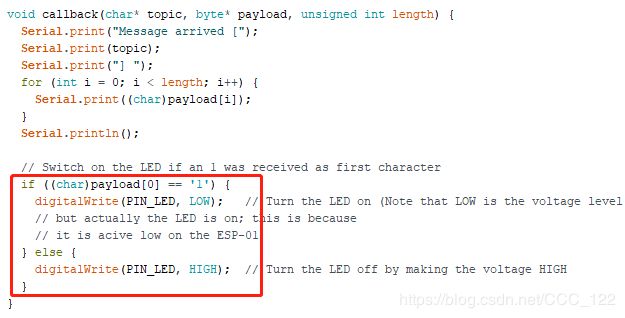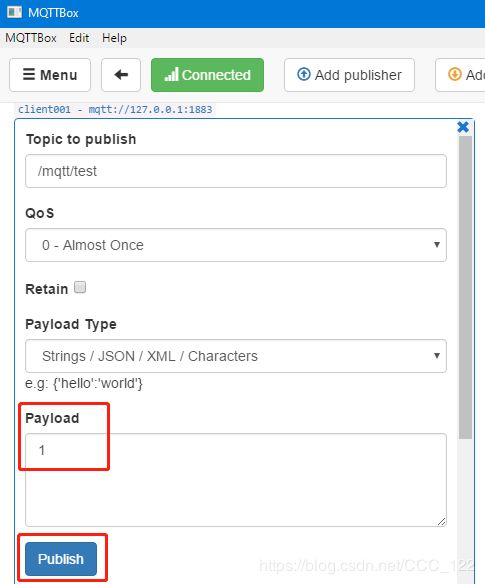- 开源WIFI继电器之硬件电路
火柴棍mcu
开源WIFI继电器ESP8266继电器WIFI
一、原理图源文件二、原理图说明1、器件说明U4:ESP8285模块U6:触发器U3:继电器2、继电器状态检测说明检测继电器线圈是否通电来判断继电器是否导通,当Q1不导通时,Q1集电极的电压为3.3V,经过R8、R9分压,ADC采集到的电压值约0.55V,当Q1导通时,Q1集电极的电压约为0.2V,经过R8、R9分压,ADC采集到的电压值约0V,所以可通过ADC采集的电压值判断继电器是否导通。
- 开源WIFI继电器之方案介绍
火柴棍mcu
WIFIESP8266MQTT继电器
一、实物1、外观2、电路板二、功能说明输出一路继电器常开信号,最大负载电流10A输入一路开关量检测联网方式2.4GWi-Fi通信协议MQTT配网方式AIrkiss,SmartConfig设备管理本地Web后台管理,可配置MQTT参数供电AC220V其它一个功能按键,三颗LED指示灯三、硬件方案ESP8285模块:ESP-01M,内置2MBFlash。
- esp32 esp8285 wf6000OTA升级小记
dabang_007
随手乱记
近期做了3个IOT芯片的OTA升级,记录下:最开始做完的是ESP32,升级流程也简单,初始烧录到固定区,然后OTA升级就会在user1,user2两个区内来回升,升级的文件是同一个(即同一个文件,先升级就是user1,再升级就变成user2)然后是wf6000,这个芯片太奇葩,文档很少不说,提供的sdk还有问题,通过代理商提了多次issue后,解决了ota的问题,但是还有个函数缺失...然后是最基
- ESP8285 RTOS SDK OTA
火柴棍mcu
ESP32/ESP8266ESP8266OTARTOS
一、官方资源说明官方指南:空中升级(OTA)-ESP32-—ESP-IDF编程指南v4.3.6文档,虽然是正对ESP32的,但是原理是一样的。官方参考例程:esp-idf\ESP8266_RTOS_SDK\examples\system\ota\,其中包含两个例程,一个是simple_ota_example,另一个是native_ota。simple_ota_example例程调用的是封装之后函数
- ESP8285 多个bin文件合并烧录
火柴棍mcu
ESP32/ESP8266数学建模linuxubuntu
可通过两种方式烧录固件,一种是基于esp-idf开发时,中命令终端执行makeflash命令烧录;二是使用ESPFlashDownloadTool工具。bin文件说明ESP8285/ESP8266的固件一般包含4个bin文件。查看各bin文件的路径以带OTA的固件为例,在命令终端执行make之后,会显示每个bin文件存放的路径及在Flash中的地址,编译结果如下:Toflashallbuildou
- ESP8285+WS2812+MAX9814制作的音乐律动氛围灯
贾saisai
ESP8266学习学习单片机c语言arm
该项目主要参考了立创EDA开源广场的项目:esp8285芯片ESP-01F模块为主控,MAX9814音频采集模块,WS28122020rgb灯珠,Arduino编程环境简单制作一个律动灯条。因为正在学习硬件PCB,所以只能算是一个仿照。硬件:下面附上原理图和pcb:相比原项目,我做的只是一个学习项目,为了能白嫖pcb打样,原来的30个ws2812我只用了20个,原项目的自动下载电路IMH3A因为太
- 记一次ESP01F烧写失败(efuse check error)的解决
KayFelicities
烧写工具用错导致efusecheckerror错误ESP01F是ESP8285芯片而不是8266,用8266烧写工具就会报efusecheckerror错误,见下图:无法烧写.png为啥我这么傻我承认,是我没好好看文档,并且把问题想复杂了。其次google搜到很少相关问题,不然我也不至于这么狼狈。然后我的烙铁也不太好用,按文档上说的260度根本没法焊接,所以用350度焊的,一直担心自己焊接温度太高
- 如何用ESP8266/ESP8285做一个WIFI中继(WiFi信号放大器)
买模块找张松
准备工作准备一个深圳四博智联科技有限公司的ESP-F模组。或者四博智联科技的NODEMCU当我们拿到ESP-F模块后,可以按照以下接线进行测试:即VCC、EN接3.3v、GPIO15GND接地、模块的TX、RX接串口工具的RX、TX、RST引脚低电平复位,不需要的IO脚位可以悬空、如果要下载模块里面的固件请把GPIO0做拉低处理(温馨提示:如果您购买的是ESP-01S/M/F1/F2只需要接VCC
- esp8266 wifi 中继整理
wowocpp
esp8266
1esp_wifi_repeater全功能WiFi中继器(正确:WiFiNAT路由器)esp_wifi_repeater,全功能WiFi中继器https://blog.csdn.net/hjf0124/article/details/86514742这是在esp8266和esp8285上的WiFiNAT路由器的实现。它还支持包含acl。端口映射。流量调整。远程监控(或者数据包嗅探)和电源管理的包过
- 探索ESP8285(3)通过EMQX服务器点亮一个LED灯
CCC_122
ESP8285
CCC_122:博客只用于学习交流,不涉及任何商业用途,如果有错误之处,欢迎指正。在上一个博客的基础上探索ESP8285(2)搭建Windows版MQTT服务器我们来通过EMQX服务器点亮ESP8285模块上的LED灯。首先查得ESP8285模块上的LED灯引脚是GPIO4,低电平亮起,所以我们先定义GPIO口在setup里设置引脚为输出模式在连接里修改订阅的主题为/mqtt/test/在call
- ESP8266 简单研究 ESP8285 研究
wowocpp
电路硬件
网址:http://wiki.ai-thinker.com/esp8266ESP8266系列模组专题概述ESP8266系列模组是深圳市安信可科技有限公司开发的一系列基于乐鑫ESP8266的超低功耗的UART-WiFi模块的模组,可以方便地进行二次开发,接入云端服务,实现手机3/4G全球随时随地的控制,加速产品原型设计。模块核心处理器ESP8266在较小尺寸封装中集成了业界领先的TensilicaL
- 关于ESP8266和ESP8285的对比
weixin_30846599
ESP8285=ESP8266+1MFlash。与ESP8266相比,其能耐高温达125摄氏度!且原有ESP8266源码程序可以原封不动移植使用。ESP-M1/M2模块核心处理器采用高性价比芯片ESP8285。该芯片在较小尺寸封装中集成了增强版的Tensilica’sL106钻石系列32-bit内核处理器,带片上SRAM。ESP8285拥有完整的Wi-Fi网络功能,既能够独立应用,也可以作为从机搭
- 如何使用ESP8266、ESP8285做一个WiFi中继(WiFi信号放大器)
weixin_30711917
准备工作准备一个深圳四博智联科技有限公司的ESP-F模组。或者四博智联科技的NODEMCU当我们拿到ESP-F模块后,可以按照以下接线进行测试:即VCC、EN接3.3v、GPIO15GND接地、模块的TX、RX接串口工具的RX、TX、RST引脚低电平复位,不需要的IO脚位可以悬空、如果要下载模块里面的固件请把GPIO0做拉低处理(温馨提示:如果您购买的是ESP-01S/M/F1/F2只需要接VCC
- ESP8266/8285 RTOS_SDK开发日记(1)
shinhwalin
ESP8266/8285
一、准备编译环境开发环境:win10+官方提供VirtualBox和OVA镜像编辑工具:sourceinsight3.5芯片:ESP8285,内置1MFLASH没有外接FLASH注意:在本地D盘下创建D:\VM\share目录,这是官方最稳定的mnt路径。将RTOS_SDK拷贝到D:\VM\share目录下,解压,并且在SDK根目录创建app文件夹。此时已经准备好编译环境。SDK下目录,官方文档上
- esp8266及esp8285二次开发(rtos)
当霸气遇到侧漏
嵌入式esp8266
esp8285与相比多了个内置1m的flash一、编译编译以及烧写也是这两个差异编译也就是makefile的差异esp8266的makefile在这里插入图片描述esp8285的makefile二、烧录windows下烧录esp8266:esp8285:三、开发开发方式采用了SDK,我这里采用了RTOS的SDK,网站如下:https://www.espressif.com/zh-hans/supp
- 探索ESP8285(1)搭建arduino开发ESP8285环境搭建
CCC_122
CCC_122:博客只用于学习交流,不涉及任何商业用途,如果有错误之处,欢迎指正。前言:ESP8285其实是ESP8266的升级版本,两者可以共用同一套SDK,只是ESP8285内部集成了1MBFlash,SPIMode设置为DOUT,而ESP8266则需要外接Flash,并且是Din模式;除此之外,ESP8285还比ESP8266额外多出GPIO9和GPIO10供用户使用。参考教程:arduin
- ESP8266与ESP8285开发时有什么区别
学为所用
物联网之嵌入式单片机嵌入式开发
ESP8266与ESP8285开发时有什么区别ESP8266与ESP8285开发时有什么区别烧录环节的改变编译前Makefile文件的更改ESP8266与ESP8285开发时有什么区别ESP8266模块在WiFi联网领域已经被广泛使用,但是ESP8266芯片是需要外挂Flash芯片的,这样就使模块不能做的更小。之后乐鑫公司又推出了ESP8285芯片,直接集成了1MByte的Flash于芯片内,各厂
- ESP8266/8285第一次打印HelloWorld
哈哈哇呀
WIFI随笔
ESP8285第一个HelloWorld搭建开发环境导入工程编译,打印HelloWorldSDK下载导入修改编译固件下载串口显示ESP8285:ESP8266内封8MbitFlash。如下记录开发环境的搭建以及第一次编译打印HelloWorld。搭建开发环境使用安信可一体化开发环境。参考地址:http://wiki.ai-thinker.com/ai_ide_install软件下载地址:http:
- Sipeed M1W内部esp8285固件烧录教程
Argon_Ghost
嵌入式
Sipeed的K210是真的香啊,但是内部的这个esp8285是做的真的不咋地。买回来之后这个8285折腾死我了,好几次固件出问题,掉固件,问了客户姐姐和群主“泽畔”大佬才解决,所以总结下。下载固件:首先我们需要先下载8285的固件,在模组的内部是k210是通过串口2和8285进行连接的,8285使用的是AT固件所以我们直接下载乐鑫官网的固件即可。不要使用安信可的固件,因为安信可的固件和8285不
- esptool.py 介绍和使用
乐鑫科技 Espressif
基础入门(GetStarted)esptoolesptool.py用法ESP32ESP8266
一:esptool.py简介esptool.py是乐鑫提供的开源库工具,用于乐鑫ESP8285,ESP8266,ESP32,ESP32-S等系列芯片和ROMBootloader(即:一级bootloader)通讯,从而实现:固件烧录,flash擦除,flash读取,读MAC地址,读flashid,elf文件转bin等常用功能;flash校验,读取内存,载入bin到RAM执行,读内存,写内存,读fl
- ESP8266/ESP8285 启动报错 csum err ets_main.c 解决办法
QQ547176052
8266
etsJan82013,rstcause:2,bootmode:(3,6)load0x40100000,len25020,room16tail12chksum0xefho0tail12room4load0x00000000,len0,room12tail0chksum0xefload0x00000000,len0,room4tail0chksum0xefcsum0xefcsumerrets_mai
- ESP8285烧写问题备忘
iotisan
联-WiFi
1问题现象ESP8285烧写了固件,怎么都跑不起来,串口打印如下信息:etsJan82013,rstcause:2,bootmode:(3,7)load0x4010f000,len1384,room16tail8chksum0xefcsum0xefcsumerrets_main.c2问题原因上乐鑫官网查了ESP8285datasheet,发现是烧写时的SPI设置不对,导致文件没成功下载进去。3.1
- JAVA中的Enum
周凡杨
javaenum枚举
Enum是计算机编程语言中的一种数据类型---枚举类型。 在实际问题中,有些变量的取值被限定在一个有限的范围内。 例如,一个星期内只有七天 我们通常这样实现上面的定义:
public String monday;
public String tuesday;
public String wensday;
public String thursday
- 赶集网mysql开发36条军规
Bill_chen
mysql业务架构设计mysql调优mysql性能优化
(一)核心军规 (1)不在数据库做运算 cpu计算务必移至业务层; (2)控制单表数据量 int型不超过1000w,含char则不超过500w; 合理分表; 限制单库表数量在300以内; (3)控制列数量 字段少而精,字段数建议在20以内
- Shell test命令
daizj
shell字符串test数字文件比较
Shell test命令
Shell中的 test 命令用于检查某个条件是否成立,它可以进行数值、字符和文件三个方面的测试。 数值测试 参数 说明 -eq 等于则为真 -ne 不等于则为真 -gt 大于则为真 -ge 大于等于则为真 -lt 小于则为真 -le 小于等于则为真
实例演示:
num1=100
num2=100if test $[num1]
- XFire框架实现WebService(二)
周凡杨
javawebservice
有了XFire框架实现WebService(一),就可以继续开发WebService的简单应用。
Webservice的服务端(WEB工程):
两个java bean类:
Course.java
package cn.com.bean;
public class Course {
private
- 重绘之画图板
朱辉辉33
画图板
上次博客讲的五子棋重绘比较简单,因为只要在重写系统重绘方法paint()时加入棋盘和棋子的绘制。这次我想说说画图板的重绘。
画图板重绘难在需要重绘的类型很多,比如说里面有矩形,园,直线之类的,所以我们要想办法将里面的图形加入一个队列中,这样在重绘时就
- Java的IO流
西蜀石兰
java
刚学Java的IO流时,被各种inputStream流弄的很迷糊,看老罗视频时说想象成插在文件上的一根管道,当初听时觉得自己很明白,可到自己用时,有不知道怎么代码了。。。
每当遇到这种问题时,我习惯性的从头开始理逻辑,会问自己一些很简单的问题,把这些简单的问题想明白了,再看代码时才不会迷糊。
IO流作用是什么?
答:实现对文件的读写,这里的文件是广义的;
Java如何实现程序到文件
- No matching PlatformTransactionManager bean found for qualifier 'add' - neither
林鹤霄
java.lang.IllegalStateException: No matching PlatformTransactionManager bean found for qualifier 'add' - neither qualifier match nor bean name match!
网上找了好多的资料没能解决,后来发现:项目中使用的是xml配置的方式配置事务,但是
- Row size too large (> 8126). Changing some columns to TEXT or BLOB
aigo
column
原文:http://stackoverflow.com/questions/15585602/change-limit-for-mysql-row-size-too-large
异常信息:
Row size too large (> 8126). Changing some columns to TEXT or BLOB or using ROW_FORMAT=DYNAM
- JS 格式化时间
alxw4616
JavaScript
/**
* 格式化时间 2013/6/13 by 半仙
[email protected]
* 需要 pad 函数
* 接收可用的时间值.
* 返回替换时间占位符后的字符串
*
* 时间占位符:年 Y 月 M 日 D 小时 h 分 m 秒 s 重复次数表示占位数
* 如 YYYY 4占4位 YY 占2位<p></p>
* MM DD hh mm
- 队列中数据的移除问题
百合不是茶
队列移除
队列的移除一般都是使用的remov();都可以移除的,但是在昨天做线程移除的时候出现了点问题,没有将遍历出来的全部移除, 代码如下;
//
package com.Thread0715.com;
import java.util.ArrayList;
public class Threa
- Runnable接口使用实例
bijian1013
javathreadRunnablejava多线程
Runnable接口
a. 该接口只有一个方法:public void run();
b. 实现该接口的类必须覆盖该run方法
c. 实现了Runnable接口的类并不具有任何天
- oracle里的extend详解
bijian1013
oracle数据库extend
扩展已知的数组空间,例:
DECLARE
TYPE CourseList IS TABLE OF VARCHAR2(10);
courses CourseList;
BEGIN
-- 初始化数组元素,大小为3
courses := CourseList('Biol 4412 ', 'Psyc 3112 ', 'Anth 3001 ');
--
- 【httpclient】httpclient发送表单POST请求
bit1129
httpclient
浏览器Form Post请求
浏览器可以通过提交表单的方式向服务器发起POST请求,这种形式的POST请求不同于一般的POST请求
1. 一般的POST请求,将请求数据放置于请求体中,服务器端以二进制流的方式读取数据,HttpServletRequest.getInputStream()。这种方式的请求可以处理任意数据形式的POST请求,比如请求数据是字符串或者是二进制数据
2. Form
- 【Hive十三】Hive读写Avro格式的数据
bit1129
hive
1. 原始数据
hive> select * from word;
OK
1 MSN
10 QQ
100 Gtalk
1000 Skype
2. 创建avro格式的数据表
hive> CREATE TABLE avro_table(age INT, name STRING)STORE
- nginx+lua+redis自动识别封解禁频繁访问IP
ronin47
在站点遇到攻击且无明显攻击特征,造成站点访问慢,nginx不断返回502等错误时,可利用nginx+lua+redis实现在指定的时间段 内,若单IP的请求量达到指定的数量后对该IP进行封禁,nginx返回403禁止访问。利用redis的expire命令设置封禁IP的过期时间达到在 指定的封禁时间后实行自动解封的目的。
一、安装环境:
CentOS x64 release 6.4(Fin
- java-二叉树的遍历-先序、中序、后序(递归和非递归)、层次遍历
bylijinnan
java
import java.util.LinkedList;
import java.util.List;
import java.util.Stack;
public class BinTreeTraverse {
//private int[] array={ 1, 2, 3, 4, 5, 6, 7, 8, 9 };
private int[] array={ 10,6,
- Spring源码学习-XML 配置方式的IoC容器启动过程分析
bylijinnan
javaspringIOC
以FileSystemXmlApplicationContext为例,把Spring IoC容器的初始化流程走一遍:
ApplicationContext context = new FileSystemXmlApplicationContext
("C:/Users/ZARA/workspace/HelloSpring/src/Beans.xml&q
- [科研与项目]民营企业请慎重参与军事科技工程
comsci
企业
军事科研工程和项目 并非要用最先进,最时髦的技术,而是要做到“万无一失”
而民营科技企业在搞科技创新工程的时候,往往考虑的是技术的先进性,而对先进技术带来的风险考虑得不够,在今天提倡军民融合发展的大环境下,这种“万无一失”和“时髦性”的矛盾会日益凸显。。。。。。所以请大家在参与任何重大的军事和政府项目之前,对
- spring 定时器-两种方式
cuityang
springquartz定时器
方式一:
间隔一定时间 运行
<bean id="updateSessionIdTask" class="com.yang.iprms.common.UpdateSessionTask" autowire="byName" />
<bean id="updateSessionIdSchedule
- 简述一下关于BroadView站点的相关设计
damoqiongqiu
view
终于弄上线了,累趴,戳这里http://www.broadview.com.cn
简述一下相关的技术点
前端:jQuery+BootStrap3.2+HandleBars,全站Ajax(貌似对SEO的影响很大啊!怎么破?),用Grunt对全部JS做了压缩处理,对部分JS和CSS做了合并(模块间存在很多依赖,全部合并比较繁琐,待完善)。
后端:U
- 运维 PHP问题汇总
dcj3sjt126com
windows2003
1、Dede(织梦)发表文章时,内容自动添加关键字显示空白页
解决方法:
后台>系统>系统基本参数>核心设置>关键字替换(是/否),这里选择“是”。
后台>系统>系统基本参数>其他选项>自动提取关键字,这里选择“是”。
2、解决PHP168超级管理员上传图片提示你的空间不足
网站是用PHP168做的,反映使用管理员在后台无法
- mac 下 安装php扩展 - mcrypt
dcj3sjt126com
PHP
MCrypt是一个功能强大的加密算法扩展库,它包括有22种算法,phpMyAdmin依赖这个PHP扩展,具体如下:
下载并解压libmcrypt-2.5.8.tar.gz。
在终端执行如下命令: tar zxvf libmcrypt-2.5.8.tar.gz cd libmcrypt-2.5.8/ ./configure --disable-posix-threads --
- MongoDB更新文档 [四]
eksliang
mongodbMongodb更新文档
MongoDB更新文档
转载请出自出处:http://eksliang.iteye.com/blog/2174104
MongoDB对文档的CURD,前面的博客简单介绍了,但是对文档更新篇幅比较大,所以这里单独拿出来。
语法结构如下:
db.collection.update( criteria, objNew, upsert, multi)
参数含义 参数
- Linux下的解压,移除,复制,查看tomcat命令
y806839048
tomcat
重复myeclipse生成webservice有问题删除以前的,干净
1、先切换到:cd usr/local/tomcat5/logs
2、tail -f catalina.out
3、这样运行时就可以实时查看运行日志了
Ctrl+c 是退出tail命令。
有问题不明的先注掉
cp /opt/tomcat-6.0.44/webapps/g
- Spring之使用事务缘由(3-XML实现)
ihuning
spring
用事务通知声明式地管理事务
事务管理是一种横切关注点。为了在 Spring 2.x 中启用声明式事务管理,可以通过 tx Schema 中定义的 <tx:advice> 元素声明事务通知,为此必须事先将这个 Schema 定义添加到 <beans> 根元素中去。声明了事务通知后,就需要将它与切入点关联起来。由于事务通知是在 <aop:
- GCD使用经验与技巧浅谈
啸笑天
GC
前言
GCD(Grand Central Dispatch)可以说是Mac、iOS开发中的一大“利器”,本文就总结一些有关使用GCD的经验与技巧。
dispatch_once_t必须是全局或static变量
这一条算是“老生常谈”了,但我认为还是有必要强调一次,毕竟非全局或非static的dispatch_once_t变量在使用时会导致非常不好排查的bug,正确的如下: 1
- linux(Ubuntu)下常用命令备忘录1
macroli
linux工作ubuntu
在使用下面的命令是可以通过--help来获取更多的信息1,查询当前目录文件列表:ls
ls命令默认状态下将按首字母升序列出你当前文件夹下面的所有内容,但这样直接运行所得到的信息也是比较少的,通常它可以结合以下这些参数运行以查询更多的信息:
ls / 显示/.下的所有文件和目录
ls -l 给出文件或者文件夹的详细信息
ls -a 显示所有文件,包括隐藏文
- nodejs同步操作mysql
qiaolevip
学习永无止境每天进步一点点mysqlnodejs
// db-util.js
var mysql = require('mysql');
var pool = mysql.createPool({
connectionLimit : 10,
host: 'localhost',
user: 'root',
password: '',
database: 'test',
port: 3306
});
- 一起学Hive系列文章
superlxw1234
hiveHive入门
[一起学Hive]系列文章 目录贴,入门Hive,持续更新中。
[一起学Hive]之一—Hive概述,Hive是什么
[一起学Hive]之二—Hive函数大全-完整版
[一起学Hive]之三—Hive中的数据库(Database)和表(Table)
[一起学Hive]之四-Hive的安装配置
[一起学Hive]之五-Hive的视图和分区
[一起学Hive
- Spring开发利器:Spring Tool Suite 3.7.0 发布
wiselyman
spring
Spring Tool Suite(简称STS)是基于Eclipse,专门针对Spring开发者提供大量的便捷功能的优秀开发工具。
在3.7.0版本主要做了如下的更新:
将eclipse版本更新至Eclipse Mars 4.5 GA
Spring Boot(JavaEE开发的颠覆者集大成者,推荐大家学习)的配置语言YAML编辑器的支持(包含自动提示,


